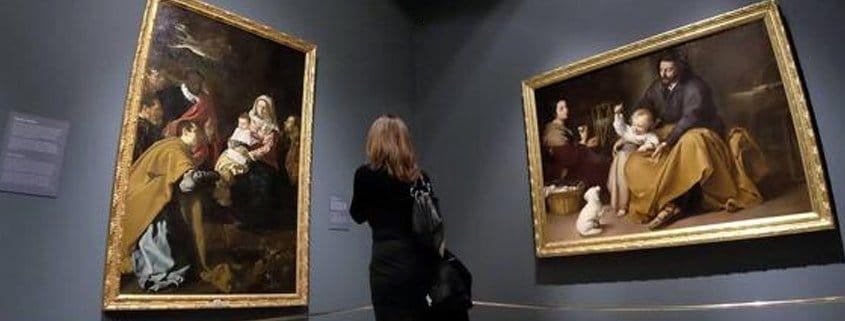Velazquez and Murillo. Exhibition in the Old Hospital of Venerable Priests at the Barrio Santa Cruz
In the Plaza de los Venerables, in the heart of the Santa Cruz neighborhood, we have now the opportunity to contemplate since last November 8th an interesting exhibition of two of the most famous artists of Seville. It is one exhibitions of the autumn that is part of the events of the 500th anniversary of the birth of Murillo (1617-2017).
The paintings come mainly from the Prado Museum, also from the National Gallery of London, private collections and the collection of Focus Abengoa that houses the exhibition.
Diego de Silva Velazquez and Bartolomé Esteban Murillo, two illustrious Sevillians, have in common many features that this exhibition, organized by the Focus Abengoa Foundation, now show us.
Diego Velázquez, the painter of the Court
The eldest of them, Diego Velazquez was born in Seville in 1599, he began to work and painted his first works in this city, first like disciple of the painter Herrera the Elder, after with Francisco Pacheco, also painter and writer, of who soon would become son-in-law after marrying his daughter.
Nevertheless the career of Velazquez took an unexpected turn when he received in 1624 the call of the young king Felipe IV to go to Madrid to become the painter of the court. The rest of his career was done in the capital, so today only a few of the pictures of the brilliant painter are in Seville. Velazquez died in Madrid in 1660.
Bartolomé Murillo, the painter of the Immaculate
Bartolome Esteban Murillo was also born in Seville but in 1617. Unlike Velazquez, he remained in this city until his death in 1681 and in his long life he worked for churches, convents, monasteries and for the famous Cathedral of Seville where even today there are some of his best works.
Both painters represent the baroque style and left to us the best works of the painting of seventeenth century.
The exhibition raises as a common thread the fact that the artists could get to know each other. There is no documentary evidence, but it is quite probable that Murillo knew the works of the first period of Velazquez, in those time in churches and schools in Seville. And also it’s quite possible that the mature Velazquez had news of the fame of a young Murillo, who in the middle of the seventeenth century became the best and most famous painter of the southern city.
The exhibition of the Hospital of Venerables bring us pictures of the two painters on the same themes. They represented scenes such as The Holy Family, the Immaculate Conception, the patrons of Seville Justa and Rufina or the endearing customs scenes that reflected the society of their time.
The study of light, the use of chiaroscuro, colors, themes .. similarities and differences between the two Sevillians, one from the Court of Madrid and another from the perspective of southern convents and monasteries.
A curiosity about Velazquez and Murillo
The graves of both artists in Madrid and Seville respectively are today missing.
Velazquez was buried in 1660, the year of his death, in the church of San Juan Bautista, in the Madrid of the Austrias, that was destroyed in time of Napoleon. Some remains of the crypt have been found in the Plaza de Ramales, where a column with a cross recalls the famous painter.
Something similar happened to Murillo. When the sevillian Church of Santa Cruz (in the present Square of Santa Cruz) in the time of the Napoleonic invasion was demolished, the remains of Murillo got lost. There is only one plaque on a facade of the plaza that reminds of the city’s best-known painter.
Where you can see the exhibition
Foundation. In addition to being a beautiful example of the Baroque Seville arquitecture, it has an interesting cultural activity organizing conferences, courses, organ concerts and exhibitions such as this that we are lucky to see until late February.
Don’t miss
The magnificent baroque church, decorated with Valdes Leal frescoes and the best painters and sculptors of the 17th and 18th centuries. Mention aside it is the modern organ of baroque inspiration that is considered one of the best of this type in Europe and that is usually used in the season of concerts in the same church of the Venerables.
The recessed patio, an original aesthetic solution of the architect Leonardo de Figueroa and that also had the practical function of collecting much more water of rain than a well or normal cistern. Essential thing in a building dedicated to Hospital.






